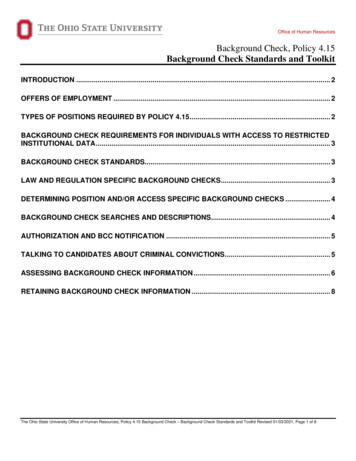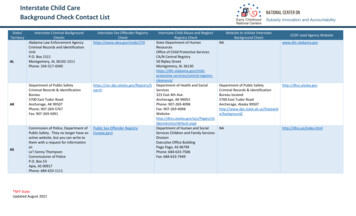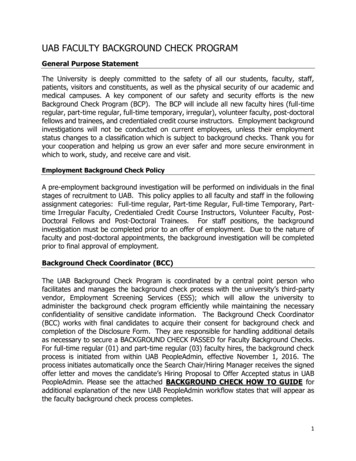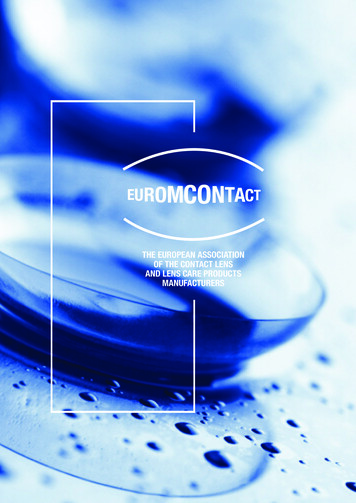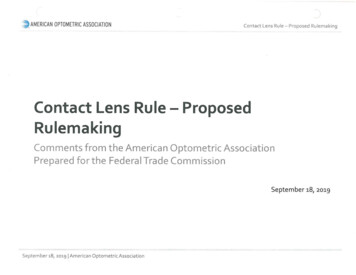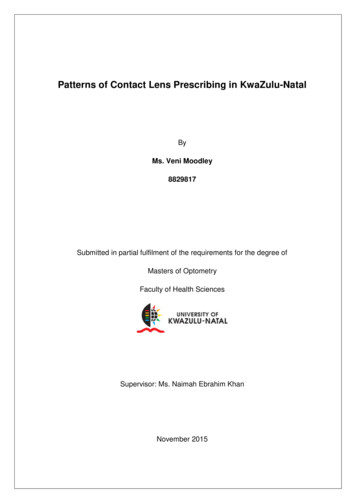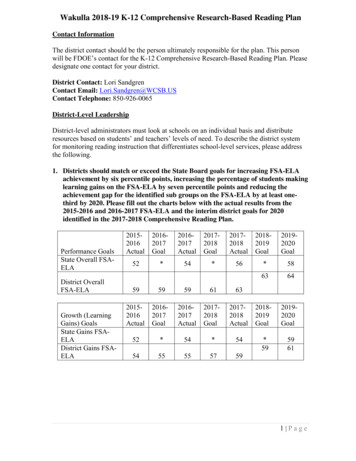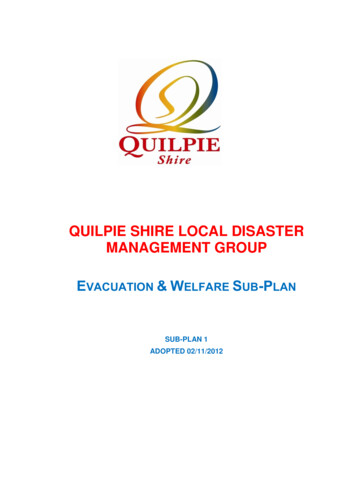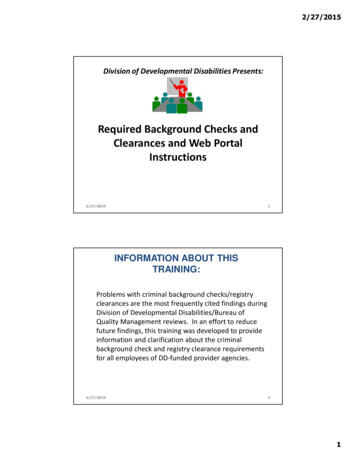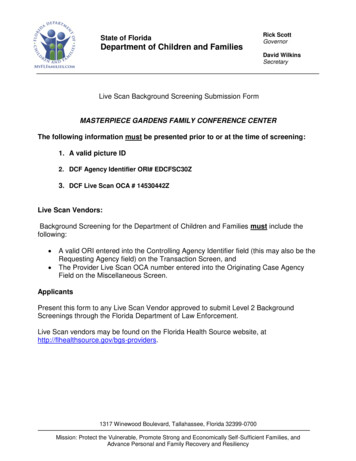
Transcription
Learning ObjectivesAfter this session, participants will be able toIntroduction to ContactInvestigation Process1. Explain the purpose of a TB contact investigation2. Describe core concepts and skills that are requiredto conduct a TB contact investigation3. Determine when to initiate a TB contactinvestigation4. Describe the systematic approach to conducting aTB contact investigation12Contact Investigations:A Priority TB Control ActivityPriority TB Control Activities1.Identify and treat persons who have active TB disease2.Find and evaluate persons who have been in contactwith TB cases and provide appropriate latent TBinfection (LTBI) or TB disease treatment as needed3.Use targeted testing strategies to identify and treatpersons with LTBI at risk for developing TB disease4.Identify settings at high risk for transmission ofM. tuberculosis and apply effective infection-controlmeasures Conducting contact investigations (CIs) is oneof the highest priorities for TB programs in theUnited States– Second in importance only todetection and treatment of TB disease3What is a Contact Investigation?Who are TB Contacts?A systematic process to:Contacts are persons whohave shared airspace with aperson with infectious TBdisease. This might include Household members Friends Co-workers Others (e.g., cellmates,shelter residents) Identify persons (contacts)exposed to cases of infectiousTB disease Assess contacts for infectionwith M. tuberculosis and TBdiseaseCaseContact Provide appropriate treatmentfor contacts with LTBI or TBdisease45Introduction to Contact Investigation Process16
Why is it Important to Conduct TBContact Investigations? (1)Why is it Important to Conduct TBContact Investigations? (2) On average, 10 contacts are identified forCIs help to:each case Interrupt spread of TB– 20% to 30% of household contacts haveLTBI Prevent outbreaks of TB– 1% of contacts have TB disease Ensure appropriate treatment for LTBI or TBdisease7Who is Responsible for TBContact Investigations?8Group Discussion State and local health departments have legalresponsibility to– Investigate TB cases reported in theirjurisdiction– Evaluate effectiveness of TB investigations Share a few examples from your CIexperience when you successfully identifiedactive TB cases. What are some barriers to conducting CIs in Although the health department maintains legalresponsibility, some CI steps may be delegated– For example, with worksite exposures,occupational health offices are often involvedyour area?109What Core Concepts and Skills are Requiredto Conduct TB Contact Investigations? Knowledge of TB transmissionCore Concepts and SkillsRequired for ConductingTB Contact Investigations Knowledge of TB pathogenesis– Difference between LTBI and TB disease– Risk factors for progressing to TB disease Effective interviewing skills Data management and analysis skills11Introduction to Contact Investigation Process212
Remember: TB is TransmittedPerson to Person!Every TB case Began as aTB contactContact InvestigationCore ConceptsTB caseTB TransmissionTB caseTB ContactsTB cases13TB Contacts14What Factors InfluenceTB Transmission?TB TransmissionThe probability that TB will be transmitteddepends on the following factors:The dots in theair representdroplet nuclei1. Infectiousness of person with TB disease2. Duration and frequency of exposure3. Environment in which exposure occurred When a person with infectious TB disease coughs, sneezes,speaks, or sings, tiny particles containing M. tuberculosis(droplet nuclei) may be expelled into the air. If another person inhales droplet nuclei, transmission mayoccur; however, not everyone who is exposed to TBbecomes infected with TB.151. Infectiousness of Person with TB DiseaseCharacteristics associated withinfectiousness: TB of the lungs, airway, or larynx and prioritized:86Why Conduct a Contact Assessment?Allows for Determination of contacts’ potential TB Contacts should be locatedsymptoms Gathering of social and medical information* Contact assessments should be conducted Referral or in-person testing for TB infectionwith a TST or IGRA Provision of treatment as indicated* Key information to collect during contact assessmentwill be discussed later in the course8788Initial Contact Assessment:Contacts with TB SymptomsWhen and How Should a ContactAssessment be Conducted? The initial contact assessmentDuring the initial assessment, all contactswith symptoms of TB disease should beimmediately examined by a medicalprofessional.should be within 3 workingdays of the contact havingbeen identified Should be conducted inperson Investigator should useeffective communication skills89Introduction to Contact Investigation Process1590
Initial Contact Assessment:Testing for TB Infection - TST or IGRA Contacts should receive a TST orWindow Period The window period is the time span between theIGRA unless a previous, documentedpositive result existscontact’s last exposure to the case and when a TSTor IGRA can reliably detect infection A TST induration of 5 mm or larger is It takes 2 to 10 weeks after TB infection for the bodypositiveto mount an immune response that is detectable by aTST* A contact with a– Positive TST or IGRA should bemedically examined for TB disease– Negative TST or IGRA shouldbe re-tested 8 to 10 weeks after dateof last exposure to the case Therefore, it is recommended to repeat a TST or IGRAfor contacts 8 to 10 weeks after date of last exposureto a TB case* Data on the timing of IGRA conversion after a newinfection are not currently available; however, it isrecommended to follow TST guidelines.9291Calculating the Window Period (2)Calculating the Window Period (1) What was the date of the contact’s last exposure tothe case?– Identify the infectious period of the case– Identify when each contact had last exposureOnly 4 weeks havepassed sincecontact’s lastexposure to TBcaseContact’s lastexposure toTB case Calculate 8 to 10 weeks from last exposure– Administer a TST or IGRA for each contact whoContact’s window periodis the time span between contact’s lastexposure to TB case and when TST orIGRA can reliably detect infectionInitial TST/IGRAis negativeContact should have repeatTST/IGRA8 to 10 weeks after lastexposuretested negativeJun 15 Jul 1 Jul 15 Aug 1 Aug 15 Sep 1 Sep 15Oct 1Oct 154 weeks9310 weeks94What if a Contact has LTBI or TB Disease?Assessment and Management of Children The decision to test a contact is a commitment to After ruling out TB disease, contacts younger than 5offer treatment If TB disease is ruled out, contacts with a positiveTST or IGRA should be offered LTBI treatment– Regardless of whether they received BCGvaccine in the past– Unless there is a compelling reason not to treat Contacts with TB disease need to be treated underDOTyears of age should start treatment for LTBI even ifthey have a negative initial TST or IGRA result LBTI treatment can be stopped if a second TST orIGRA done 8 to 10 weeks after exposure is negative– However, if contact is under 6 months of age, LTBItreatment should be continued until contactreaches 6 months of age and a second TST/IGRAis negative95Introduction to Contact Investigation Process1696
Assessment and Management of Contactswith Weakened Immune Systems A full medical evaluation, including a chest x-ray, shouldbe given to contacts– With HIV/AIDS– On immunosuppressive therapy for organ transplant– Taking anti-tumor necrosis factor alpha (TNF-α) agents If both initial and follow-up TST/IGRA are negative, a fullcourse of prophylactic LTBI treatment is recommended(after TB disease is excluded)Systematic Approach toTB Contact Investigations9. Determine Whether toExpand or Conclude anInvestigation Expert consultation should be sought for contacts withother immunocompromising conditions9798When Should a ContactInvestigation be Expanded?When Can you Close aContact Investigation?A CI can be closed if Identified contacts have been assessed for TB inaccordance with local policy– At some point, the TB program must decidewhen all reasonable investigative efforts havebeen exhausted Contacts with LTBI have completed or are closeto completing treatment No additional active TB cases among contactsSometimes a CI has to be expanded if there is evidenceof recent transmission Unexpectedly high TB disease or LTBI rates amongpriority contacts Large number of contacts with change in infectionstatus from negative to positive TB disease in any contacts who had been assignedlow priority or TB disease in those previously notidentified as contacts Infection in any contacts younger than 5 years of age99Expanding a Contact Investigation100Other Important ConsiderationsDuring a Contact Investigation If a second TB case is found during the CI, this Decision to expand CI should be based onsecond case needs their own CI.the investigation data– Results should be reviewed weekly If a case is considered highly infectious andyou find few contacts and/or find little evidenceof transmission, you may need to go back andreview your records and determine if a reinterview is needed. Decision should be made by supervisorystaff In the absence of recent transmission, theinvestigation should not be expanded tolower-priority groups101Introduction to Contact Investigation Process17102
Evaluating Contact InvestigationActivities (1)The purpose of evaluating the activities of the CI isto determine:Systematic Approach toTB Contact Investigations If an appropriate number of contacts wereid
Effective Interviewing Skills 29 Contact Investigation Core Concepts Effective Interviewing Effective interviewing skills are essential for eliciting information from cases and their contacts Interview skills can be taught Interview skills improve with practice 30 The focus of this course is on building these skills

